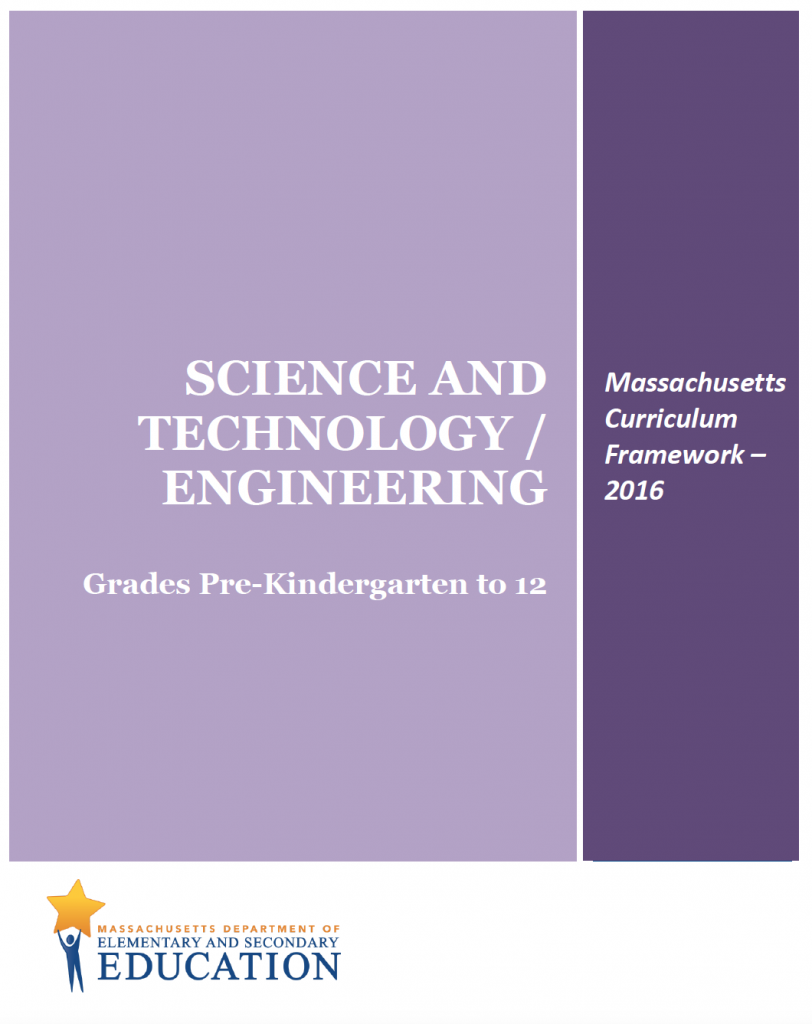Science and Technology/Engineering

Science and Technology/Engineering Education for All Students: The Vision[1]
Our world has never been so complex, and scientific and technological reasoning have never been so necessary to make sense of it all. It is self-evident that science, technology, and engineering (STE) are central to the lives of all Massachusetts citizens when they analyze current events, make informed decisions about healthcare, or decide to support public development of community infrastructure. By the end of grade 12, all students must have an appreciation for the wonder of science, possess sufficient knowledge of science and engineering to engage in public discussions on related issues, and be careful consumers of scientific and technological information and products in their everyday lives. Students’ STE experience should encourage and facilitate engagement in STE to prepare them for the reality that most careers require some scientific or technical preparation, and to increase their interest in and consideration of careers in science, technology, engineering, and mathematics (STEM). All students, regardless of their future education plan and career path, must have an engaging, relevant, rigorous, and coherent pre-K–12 STE education to be prepared for citizenship, continuing education, and careers.
Qualities of Science and Technology/Engineering Education for All Students
Student engagement with science and technology/engineering is a critical emphasis that can only be achieved through quality curriculum and instruction. The standards attend to relevance, rigor, and coherence, each of which has a corresponding implication for curriculum and instruction:
Engagement
Students need regular opportunities to experience the dynamic, interdisciplinary nature of science and technology/engineering. Curriculum and instruction should instill wonder in students about the world around them through engaging and exciting learning experiences. Students should develop a passion about the natural and designed world and model the inquisitive, analytical, and skeptical nature of science. These goals can only be achieved through a rich and varied STE curriculum that includes thoughtful hands-on and minds-on activities, laboratories, investigations, and design challenges. Students take ownership and responsibility in their learning when they have a role in making decisions and reflecting on their learning. Active engagement in learning promotes a “growth mindset” that allows students to feel they can access content and develop skills, and thus succeed in STE. Instruction designed for student engagement is key to achieving this.
Relevance
Students often want to know why they are learning content in the classroom that seems unrelated to the real world. To understand the world around them, and be more interested in learning about it, they must have opportunities to apply their learning to relevant situations and contexts. The STE standards emphasize the application of knowledge and skills that students need to be analytical thinkers and problem solvers for issues that are crucial in today’s world. Relevance in curriculum and instruction is also about meeting the needs of diverse learners, including minorities, females, and those on Individualized Education Program, of low socioeconomic status, or otherwise not traditionally represented in science, technology, and engineering. To focus on relevance, the STE standards emphasize fewer core ideas over lists of discrete knowledge. For example, understanding the function of living systems includes understanding the role of feedback mechanisms. Feedback mechanisms in organisms allow them to remain stable and stay alive by making changes to maintain appropriate internal conditions even as external conditions change. A similar principle applies to ecosystems and to designed systems such as home heating and cooling systems. This focus on interactions in living systems is different from an emphasis on identification of body parts or components of an ecosystem. A focus on core ideas helps students to understand mechanisms and causes underlying a range of phenomena and apply their content understandings to real-world and novel situations (NRC, 2012). Knowledge alone is not enough: students need to be able to act on that knowledge. Students need to be able to apply science and engineering practices—skills that let them analyze a natural phenomenon or designed system and determine underlying mechanisms and causes—in civic, college, and career contexts. Coupling practice with content gives the context for performance, whereas practices alone are activities and content alone is memorization. Quality STE education must attend to both in order for students to successfully apply their learning to understand and analyze their world.
Rigor
Rigor in STE teaching and learning is achieved by relating conceptual understanding of core ideas (content), science and engineering practices (skills), and application of those to the natural and designed world. Such rigor is how students will be able to apply or transfer their school learning to civic, college, and career contexts. The STE standards are explicitly designed to relate these three aspects in learning outcomes; curriculum and instruction should do so as well.
Coherence
Quality STE education is purposefully designed to support a progression of learning over time. STE education begins early, when children are natural investigators who build and ask questions in many contexts. This should be nurtured through subsequent years. Students should be engaged in developing and applying the science and engineering practices with the core ideas throughout pre-K–12. Every grade’s STE education should build on the prior year, support the development of more sophisticated skills, increase the opportunity to relate and use multiple practices at once, and provide more sophisticated concepts and tasks in which to apply the practices. Integration of practices with concepts in purposeful ways throughout pre-K–12 ensures that all students have the opportunity to learn and apply scientific and technical reasoning in a wide array of contexts and situations that they need for postsecondary success. This can only happen if curriculum and instruction is purposefully designed to be coherent across time.
Media Attributions
- Science and Technology/Engineering © Massachusetts Department of Elementary and Secondary Education is licensed under a CC BY (Attribution) license
- Massachusetts Department of Elementary and Secondary Education (2022). SCIENCE AND TECHNOLOGY / ENGINEERING Grades Pre-Kindergarten to 12 Massachusetts Curriculum Framework. https://www.doe.mass.edu/frameworks/current.html ↵

